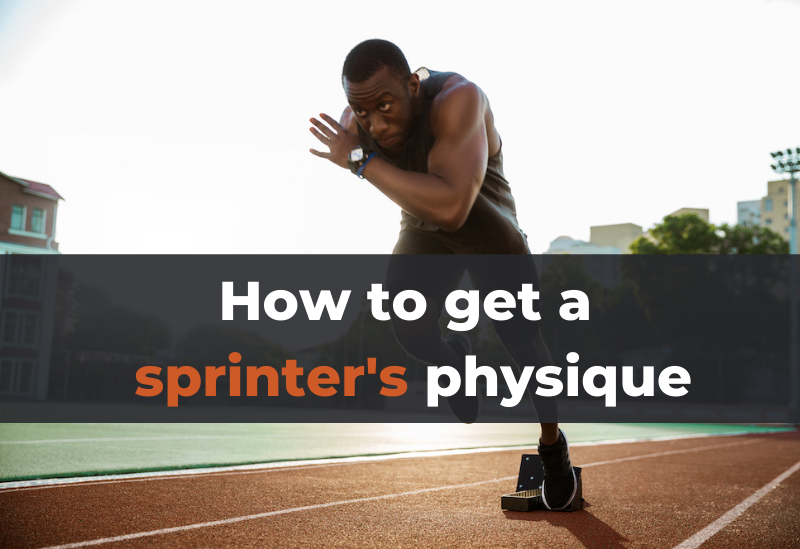You might not think the average runner has that impressive of a physique.
But sprinters on the other hand?
They’re powerful, muscular, and lean — not to mention, incredibly athletic.
It’s a body type that plenty of people covet, especially when the Olympics roll around.
So how can you get a body like a sprinter?

Sprinters are bound with muscle without being overly bulky. Their bodies are designed for short bursts of explosive power rather than long bouts of steady effort.
Sprinters are lean, jacked, and extremely impressive physique-wise.
To get a body like a sprinter, you’ll need to spend a lot of time in the gym doing full-body strength training to pack on muscle while getting or staying lean. But don’t forget to work on your athleticism too with a steady dose of running and sprinting.
I spoke with some personal trainers and fitness experts to learn more about how to achieve this highly coveted physique.
What Are the Hallmarks of the Sprinter’s Physique?
“If this question was asked 30 years ago, you would see incredibly lean physiques, similar to the distance runners.
“But now, sprinters have incredibly built and defined physiques (see Usain Bolt and Mathew Boling).”
That’s according to personal trainer Sean Orlando.
So, to put it simply: sprinters are ripped.
The main difference between distance runners and sprinters is the muscle demand between them.
Sprinters tend to build more muscle, typically in their quads and calves, for short bursts of high activity.
Though you’ll notice most sprinters are exceptionally well built in their upper bodies as well, from their backs, to their chests and arms.

They need explosive power more than endless endurance.
Olympic sprinters do a lot more than just run — they do other weight training and ab workouts in order to help with their overall performance.
But you’ll notice that Olympic sprinters don’t necessarily have the tree trunk legs of a powerlifter — and that’s because some of the muscle they build in their legs isn’t from lifting, it’s actually from sprinting.
Sprinting can aid in muscle growth, more than distance running can. Sean Orlando breaks it down:
“The energy system used by sprinters is predominantly the Creatine-Phosphate and Anaerobic (or Glycolytic) Energy System.
“These energy systems are dominated by Type II muscle fibers. These muscle fibers are much more prone to increases in size, contributing to the large defined muscles sprinters have.”
This combination of strength training and high-intensity running creates a unique, muscular, and athletic look.
5 Training Tips for a Sprinter’s Body
Training for a sprinter’s body is going to be a long and painful process, but it gets easier as you build your strength and learn to love the burn.
You should start seeing the results of your efforts relatively quickly if you go all in from the start, but it’ll be a while before you develop a body like Usain Bolt.
Still, the results of running one month on are nothing to turn away from. The changes are small, but they come on fast.
#1. Start Slow with Small Sprints
You can’t get the body without doing the actual exercise, so start off slowly.
Sean Orlando defines a sprint as anything less than 400 meters, although he admits that these days it can also be anything less than 800.
So, start with 100 meter sprints to build up your anaerobic energy system.
Sean recommends 5–10 of these short sprints per workout, with 2–3 minutes of rest in between.
If you have trouble staying motivated or getting started with your running, consider trying out some of the best running apps.
Some of them have communities that can really motivate you and keep you accountable.
Many of them are focused on distance running, but the iPhone-only app iSmoothRun is excellent for interval training.
#2. Build Your Sprinting Stamina
Building stamina when sprinting isn’t going to be easy, but with the right training and daily commitment, you can get there.
You can do this slowly, starting with the sprinting exercises outlined above but on the low end:
Start by using this simple scale:
- 100 meters
- 3-minute rest
- Repeat this pattern four more times
Once you feel comfortable doing five sets with three minutes of rest between them, cut that three minutes down to two and master that.
Then you can add in a sixth set, and if you need to, increase your rest to three minutes again.
Get used to the sixth set, then start building that up to 10 sets per workout.
Once you can do 10 reps of 100 meters at full effort, with a two-minute rest in between then you’re ready to start increasing that 100-meter distance until you reach 10 reps of 400 with two minutes in between.
Starting to see the pattern?
Don’t just run the same workout over and over, hoping to get faster and stronger.
Add difficulty, add sets, decrease rest, and mix up your workouts for the best results.
You need to be constantly pushing yourself, but never before you’re ready.
With each extra push, you build that endurance you have just a little bit more, pushing your body beyond its current limits so you can expand what those limits really are.
#3. Train Your Muscles with Weights
Of course, you should be training your muscles in the gym alongside building endurance.
You can also apply the endurance-building exercises to your strength training.
Add in one more rep per set, and/or shorten breaks, until you hit a goal you set for yourself.
In the case of muscle training it’s going from three sessions to four per week, from one rep to six in this routine outlined by Sean Orlando.
(That’s right — you’ll want to lift weights 3 or 4 times per week to look like a sprinter! You’ll probably spend more time lifting than sprinting, believe it or not.)
“For muscular training, developing strength and power is desired.
“3–4 sessions in the weight room would be adequate especially if done along a push/pull split.
“To develop this strength and power, small sets of 1–6 reps of explosive movements combined with higher volume accessory movements would be beneficial.
In other words, work on your 6 rep max for big compound movements like the bench press, squat, or deadlift.
Work in a higher rep range like 8-12 or more for exercises like bicep curls, rope pushdowns, leg extensions, etc.
Need some ideas to get started? Here are some exercises of the accessory variety that can help you increase muscular endurance and muscle size to develop that sprinter physique.
Arms
- Bicep barbell or dumbbell curl
- Dumbbell preacher curl
- Cable bicep curl
- Skull crusher
- Cable triceps pushdown
- Single-arm dumbbell overhead triceps extension
Legs
- Leg press
- Leg extension
- Inner and outer thigh machines
- Seated leg curl machine
- Straight-leg calf raises
- Plyometric lunges
- Bent-knee calf raises
- Eccentric calf raises
- Farmer’s walk on your toes
Abs
- Planks
- Hollow holds
- V-ups
- L sits
It’s best to follow a proper routine rather than making one up as you go along, but whatever weightlifting program you choose, make sure you’re maximizing explosive power in the rep ranges outlined above.
#4. Do HIIT Workouts to Save Time
High-intensity interval training is a lot like sprinting.
HIIT workouts consist of short periods of intense effort followed by quick recoveries.
They’ll help build your endurance, explosiveness, and even some muscle.
They’re also extremely efficient for us non-professional athletes who don’t always have time for a long sprinting workout on the track.
Jeff Parke of Top Fitness Magazine is a huge advocate for HIIT for sprinters, but has some warnings about it.
“Beginners also tend to only do HIIT because it doesn’t take much time but that can lead to soreness.
“It’s important to stagger HIIT workouts and rest your muscles in between sessions.
“Before you start a HIIT workout just make sure you’re able to complete the exercises without losing form. It’s easy to fatigue and injure yourself.”
A 10–30 minute HIIT session is excellent depending on how much time you have and what you can endure. You can also increase the length of the session as your stamina grows.
Just don’t overdo it with the HIIT if you’re also spending time strength training and working out on the track.
Use HIIT workouts when you’re short on time, or do 1-2 per week if it doesn’t take away from the staples of your training.
#5. Eat Clean — with Lots of Protein
There are lots of running pros and cons and weight loss is one of the pros.
In fact, getting to a low body fat percentage is a must if you want to look like a sprinter.
However, you need to be making an effort outside of the gym, too.
Eating clean — meaning a lack of empty calories with ultra-processed food — can help you maintain your weight, as well as lose any excess fat that you don’t want.
While weight training and HIIT burn calories quickly and continue burning them once you’re out of the gym, you don’t want to replace those calories by overeating.
You should also be eating lots of protein as it helps build muscle and aids in workout recovery.
Protein helps repair the microtears that occur when you’re increasing the size and strength of your muscles, which is why athletes tend to consume a lot of protein shakes and bars before hitting the gym.
Alongside any protein supplements like that, you can also consume:
- Eggs
- Low-fat airy
- Lean meat
- Poultry
- Fish
Carbs are also important for working out, and bodybuilder Stan Efferding swears by them for fuel.
Try to look for unrefined carbohydrates, like:
- potatoes
- fruit
- legumes
- whole grains
It can be tricky to shed enough weight to look shredded like a sprinter, while also getting enough fuel for your workouts.
It helps to work in cutting and bulking phases — first leaning down to get more toned and then eating more to add muscle and increase performance.
Wrapping Up
A sprinter’s body is defined by high muscle mass and explosive power, which you can achieve through:
- sprinting
- weight training
- HIIT
- and eating properly.
The important thing is to never overdo your efforts, take breaks, and build stamina slowly.
With time, you can build the muscles you see in a typical sprinter’s physique, and you can obtain their killer speed, too.
Before you go, check out:
- How to get a rower’s body
- How to get a swimmer’s body
- How to get a distance runner’s body
- How to get a ballerina body
Hope this helps!